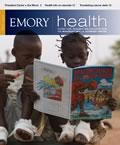An AIDS vaccine that works?
 |
This fall, leading scientists in the AIDS vaccine field gathered in Atlanta for the 10th annual AIDS Vaccine 2010 conference. The conference brought to the forefront the latest progress in developing an effective AIDS vaccine, including recent findings from Thailand that provided the first demonstration of an experimental vaccine lowering infection rates.
While the Thai trial “hasn’t taken us away from the need to generate more basic science knowledge, it did suggest that success wasn’t impossible,” says Eric Hunter, co-director of Emory’s Center for AIDS Research and conference chair. “It’s an exciting time.”
Another encouraging development is the vaccine developed by former Emory microbiologist Harriet Robinson, above left. Robinson left Emory’s Yerkes National Primate Research Center in 2008 to further develop a candidate HIV vaccine with GeoVax. The vaccine follows the blueprint that she laid out almost a decade ago at Yerkes, where experiments with rhesus macaques showed that a similar vaccine had the ability to control infection by SIV, the simian equivalent of HIV. The 24-week course of vaccination uses two doses of DNA that encode HIV components as well as two doses of a modified vaccinia virus, a benign relative of smallpox that is used as a vaccine vector.
The GeoVax preventive vaccine program, sponsored by the NIH HIV Vaccine Trials Network, is in phase 2 clinical trials in humans. It is recruiting 300 participants who are at low-risk for HIV infection at 15 sites in North America and Peru. The goal of the study is to obtain sufficient safety and immune response data for progression of the vaccine to a placebo-controlled efficacy trial in an at-risk population.
GeoVax also has started its first therapeutic trial, in which the vaccine is given to already infected participants whose bodies have stably suppressed their infection with antiretroviral drugs. The rationale for the study comes from experiments conducted by researcher Rama Amara, above right, at Yerkes with primates who have been infected with SIV, treated with anti-retroviral drugs, vaccinated, and then taken off the drugs. Usually levels of virus go back to the pre-drug set point once the primate is taken off the drugs, says Amara. If the primate is given a course of immune system-boosting vaccine while still on the drugs, the set point can be many times lower.
“If someone who is infected can control the virus to this degree, he or she might be able to avoid transmitting the virus and take fewer antiretroviral drugs,” Amara says. “It could really change that person’s life for the better.”
 |
The initial therapeutic trial—conducted by the AIDS Research Consortium of Atlanta—is recruiting a dozen patients who are within a year of HIV infection and have been able to control the virus with antiretroviral drugs. It is targeting patients for an early window of opportunity, after which the pool of viruses may mutate beyond the reach of the vaccine.
Results from recent studies on preventive vaccines with primates suggest that a next generation of vaccines could provide more robust immune protection from infection. For example, Amara and Robinson are collaborating on studies of adjuvants, extra genes that are added to the DNA of the vaccine. One of these extras, GM-CSF, has provided a strong boost to the ability of the vaccine to prevent, not just control, infections. GeoVax has added this vaccine to its pipeline.
Early results of the adjuvant research are encouraging to Robinson. “If GeoVax’s first product fails to win the battle, our reserves will be ready,” she says. –Quinn Eastman


